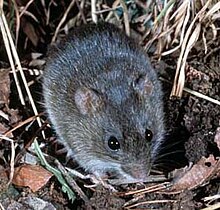
The Lagomorphs are the members of the taxonomic order Lagomorpha, of which there are two living families: the Leporidae and the Ochotonidae (pikas). The name of the order is derived from the Ancient Greek lagos + morphē. There are 102 extant species of lagomorph, including 37 species of pika, 33 species of rabbit and cottontail, and 32 species of hare.

Placentalia is one of the three extant subdivisions of the class of animals Mammalia; the other two are Monotremata and Marsupialia. The placentals are partly distinguished from other mammals in that the fetus is carried in the uterus of its mother to a relatively late stage of development. The name is something of a misnomer considering that marsupials also nourish their fetuses via a placenta, though for a relatively briefer period, giving birth to less developed young who are then kept for a period in the mother's pouch.

The family Castoridae contains the two living species of beavers and their fossil relatives. This was once a highly diverse group of rodents, but is now restricted to a single extant genus, Castor.
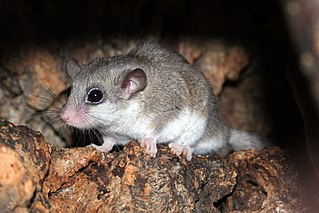
Glires is a clade consisting of rodents and lagomorphs. The hypothesis that these form a monophyletic group has been long debated based on morphological evidence. Two morphological studies, published in 2001 and 2003, strongly support the monophyly of Glires. In particular, the 2003 study reported the discovery of fossil material of basal members of Glires, particularly the genera Mimotona, Gomphos, Heomys, Matutinia, Rhombomylus, and Sinomylus. Their description, in 2005, helped to bridge the gap between more typical rodents and lagomorphs. Data published in 2001, based on nuclear DNA, supported Glires as a sister of Euarchonta to form Euarchontoglires, but some genetic data from both nuclear and mitochondrial DNA have been less supportive. A study, published in 2007, investigating retrotransposon presence/absence data unambiguously supports the Glires hypothesis. Studies published in 2011 and 2015 place Scandentia as a sister clade of the Glires, invalidating Euarchonta as a clade.
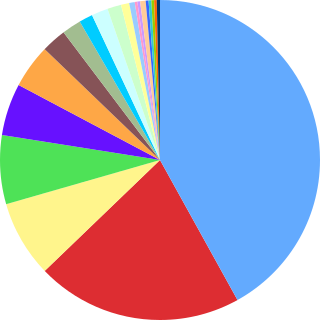
Mammalia is a class of animal within the phylum Chordata. Mammal classification has been through several iterations since Carl Linnaeus initially defined the class. No classification system is universally accepted; McKenna & Bell (1997) and Wilson & Reader (2005) provide useful recent compendiums. Many earlier ideas from Linnaeus et al. have been completely abandoned by modern taxonomists, among these are the idea that bats are related to birds or that humans represent a group outside of other living things. Competing ideas about the relationships of mammal orders do persist and are currently in development. Most significantly in recent years, cladistic thinking has led to an effort to ensure that all taxonomic designations represent monophyletic groups. The field has also seen a recent surge in interest and modification due to the results of molecular phylogenetics.

Plesiadapis is one of the oldest known primate-like mammal genera which existed about 55–58 million years ago in North America and Europe. Plesiadapis means "near-Adapis", which is a reference to the adapiform primate of the Eocene period, Adapis. Plesiadapis tricuspidens, the type specimen, is named after the three cusps present on its upper incisors.

Ferae [ FEER-ee, Latin: [ˈfɛrae̯]] is a clade of mammals, consisting of the orders Carnivora and Pholidota. An alternate name, Ostentoria, has also been proposed for a grouping of the Carnivora and Pholidota. The last common ancestor of extant Ferae is supposed to have diversified ca. 78.9 million years ago. Several extinct orders such as creodonts are members of Ferae as well.

Cimolesta is an extinct order of non-placental eutherian mammals. Cimolestans had a wide variety of body shapes, dentition and lifestyles, though the majority of them were small to medium-sized general mammals that bore superficial resemblances to rodents, weasels or opossums.

Eomyidae is a family of extinct rodents from North America and Eurasia related to modern day pocket gophers and kangaroo rats. They are known from the Middle Eocene to the Late Miocene in North America and from the Late Eocene to the Pleistocene in Eurasia. Eomyids were generally small, but occasionally large, and tended to be squirrel-like in form and habits. The family includes the earliest known gliding rodent, Eomys quercyi.
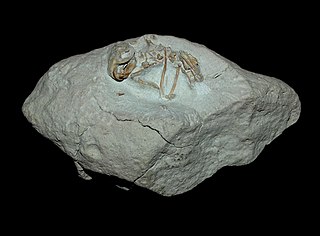
Heliscomyidae is a family of extinct rodents from the mid-Tertiary of North America related to pocket gophers and kangaroo rats and their relatives. The family contains four genera, Apletotomeus, Heliscomys, Passaliscomys, and Tylionomys. McKenna and Bell (1997) placed the first two genera in synonymy, with Heliscomys the senior synonym.
Eurymylidae is a family of extinct simplicidentates. Most authorities consider them to be basal to all modern rodents and may have been the ancestral stock whence the most recent common ancestor of all modern rodents arose. However, the more completely known eurymylids, including Eurymylus, Heomys, Matutinia, and Rhombomylus, appear to represent a monophyletic side branch not directly ancestral to rodents. Huang et al. (2004) have argued that Hanomys, Matutinia, and Rhombomylus form a clade characterized by distinctive features of the skull and dentition that should be recognized as a separate family, Rhombomylidae. Eurymylids are only known from Asia.
The Tsaganomyidae are an extinct family of rodents from Asia. It contains three genera. Tsaganomyids are generally considered to be related to the Hystricognathi. Members of Tsaganomyidae were fossorial (digging) rodents that probably used their incisor teeth to dig like some living mole rats.
Alagomyidae is a family of rodents known from the late Paleocene and early Eocene of Asia and North America. Alagomyids have been identified as the most basal rodents, lying outside the common ancestry of living forms. Because of their phylogenetic position and their conservative dental morphology, alagomyids have played a key role in investigations of the origins and relationships of rodents.

Mesotheriidae is an extinct family of notoungulate mammals known from the Eocene through the Pleistocene of South America. Mesotheriids were small to medium-sized herbivorous mammals adapted for digging.
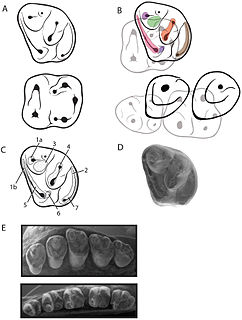
Gomphos is an extinct genus of early lagomorph from the early Eocene of the China and Mongolia.
Anagaloidea is an extinct order of mammals that first appeared during the Cretaceous period.
Hunter-Schreger bands, commonly abbreviated as HSB, are features of the enamel of the teeth in mammals, mostly placentals. In HSB, enamel prisms are arranged in layers of varying thickness at about right angles to each other. HSB strengthen the enamel and prevent cracks from propagating through the tooth.

Preptotheria is a superorder of placental mammals proposed by McKenna & Bell in their classification of mammals.
This article records new taxa of fossil mammals of every kind that have been described during the year 2013, as well as other significant discoveries and events related to paleontology of mammals that occurred in the year 2013.
This article records new taxa of fossil mammals of every kind that have been described during the year 2010, as well as other significant discoveries and events related to paleontology of mammals that occurred in the year 2010.
